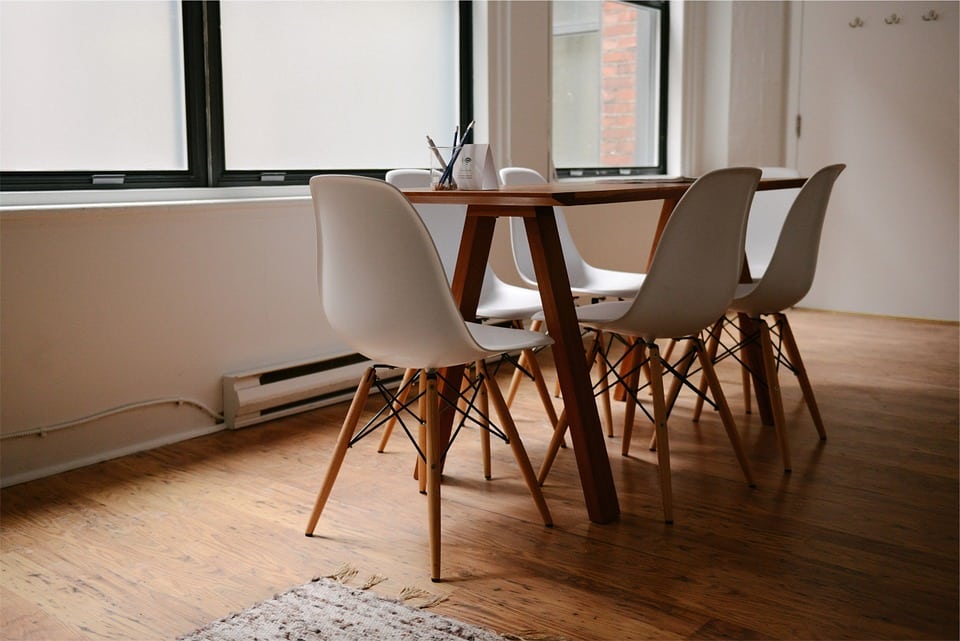Hardwood flooring has a reputation for adding class and sophistication to any space, but just how well does it hold up in a workplace environment? The answer: hardwood floors are a top-notch option for any business for a lot of reasons. No matter your business décor, there is sure to be a hardwood floor that will match and enhance your style.
Here are just a few reasons you can’t go wrong with hardwood flooring in a business setting:
- Increases Your Business’ Value: Hardwood flooring adds a lot more value than carpet and tile because of its natural beauty, longevity, and relatively low maintenance. Hardwood flooring is a major selling point in the real estate market as well.
- Durability: Depending on the type of traffic you’re expecting, some hardwood options work better than others. That said, they all have the potential to last multiple decades with relatively little maintenance.
- Aesthetically Pleasing: Plain and simple, hardwood flooring just looks good. You can pick the stain to suit your style. Regardless of what you pick, your hardwood flooring will lend a timeless, sleek appearance to your business setting.
- Easier to Clean: Wood flooring that is installed and sealed well is highly resistant to scuffs and stains. It just needs to be swept and mopped regularly to maintain its natural beauty.
- Healthier: Because there are no fibers to hold onto dirt particles, hardwood flooring is healthier for you than carpet. Dust, dander, and other allergens are easy to see and get rid of, which improves the air quality for your employees.
Two Types of Hardwood Flooring
When you’re in the market for hardwood flooring, you will run into two different types: solid and engineered. There are pros and cons to both types of flooring, so you will need to do some research as to which will work best in your space.
Solid wood flooring can come prefinished or unfinished and can even be refinished many times. If you buy it prefinished, it is typically more expensive per plank, but it has a cheaper installation. Prefinished flooring also produces little-to-no fumes or dust during install, which is safer for your employees.
On the other hand, unfinished solid wood flooring is usually cheaper per plank but has a more costly and labor-intensive install. The benefit of unfinished wood flooring is that it allows for custom colors, and there are no board-height variations because everything is sanded after installation.
Due to its very nature, solid wood flooring is prone to warping in high-humidity areas such as basements or other below-grade spaces. Because it is nailed to the floor, solid wood flooring needs a wood subfloor, so you can’t install directly over concrete. It also tends to “cup” (rise up in the center parallel with the grain) or “bow” (rise up in the center perpendicular to the grain) in areas that have high humidity and temperature fluctuations.
Engineered wood flooring comes prefinished and is usually a little bit cheaper than solid wood flooring. Due to the engineered process of laying a veneer over layered wood and resin, this type of hardwood flooring is much more resistant to warping. It can be installed over any level surface because it is typically installed as a “floating floor,” which means that it is not nailed down to the ground. The benefit to this type of install is that the flooring accommodates both expanding and contracting caused by temperature and humidity. Engineered wood flooring can only be refinished once or twice over its lifetime because it only has that thin layer of veneer on top.
Types of Wood
- Cherry is the softest wood on this list, so it is best installed in areas that only get light foot traffic. It is an extremely warm wood, and it has large, elegant swirl patterns that are showcased in wide planks. Cherry does tend to darken over time and when exposed to a lot of light, so keep that in mind.
- Walnut has a medium hardness, so it should only be installed in areas that get medium traffic. It has deep, dark tones that are usually straight but can swirl and, at times, appear almost metallic in the way they catch the light. Walnut is a very dramatic choice.
- Red Oak is a very hard option for your flooring, which makes it great for areas that get a lot of foot traffic. It tends to have large cathedrals (flowing arch patterns in the wood grain) and swirls that create visual appeal but also give a lot of variation in how it aborbs stain. The red undertones make this wood appear warm and inviting.
- White Oak is even harder than red oak so it’s a safe bet for high-traffic areas, but it appears less warm than Red Oak due to the lack of red in the wood. There is also minimal variation in the grain, so it maintains a fairly standard appearance across the project.
- Maple is a fine-grained, light-colored, warm wood that is harder than white oak but softer than hickory.
- Hickory is the hardest wood in this list, so if you have a work environment that might take a beating, this is the wood for you. It has a lot of natural flaws like knots and cathedrals, so you will see a lot of variation in your stain. This is perfect for anyone going for rustic appeal.
Hardwood flooring is a beautiful and renewable type of flooring that can add a lot of value to your business.

